Daylilies are among the most cherished and versatile plants in the garden. Despite their name, daylilies are not true lilies but belong to the genus Hemerocallis. Their name derives from the Greek words “Hemera,” meaning day, and “Kallos,” meaning beauty, referring to the flowers that typically bloom for just one day.
With thousands of cultivars available in a stunning array of colors, patterns, and sizes, daylilies are favorites among both novice gardeners and seasoned horticulturists. They are celebrated for their hardiness, adaptability, and low-maintenance needs. From border plantings to container gardens, daylilies can thrive in various landscapes and climates.
The allure of daylilies is further enhanced by their edible qualities. Many parts of the plant, including the buds and flowers, are often used in culinary dishes. This multifaceted aspect adds to their charm, making them not just a visual delight but a functional addition to gardens and kitchens alike.
| Attribute | Details |
|---|---|
| Common Names | Daylily |
| Botanical Name | Hemerocallis |
| Family | Asphodelaceae |
| Plant Type | Perennial |
| Mature Size | 1-4 feet tall, 1-3 feet wide |
| Sun Exposure | Full sun to part shade |
| Soil Type | Well-drained, variety of types |
| Hardiness Zones | 3-10 |
| Native Area | Asia |
Daylilies Care
Caring for daylilies is relatively simple, making them an ideal choice for gardeners of all skill levels. They thrive in various soil conditions and can adapt to different lighting scenarios, though they prefer full sun. Daylilies are also known for their drought tolerance, further adding to their reputation as an easy-to-care-for plant.
Fertilizing, watering, and occasional division ensure a healthy and vibrant growth pattern. Regular monitoring for pests and diseases helps in maintaining the plants in top shape, though daylilies are known to be quite resilient. Their adaptability and minimal care needs make them an attractive option for a wide variety of garden settings.
Light Requirement for Daylilies
Daylilies grow best in full sun but can tolerate part shade. At least six hours of sunlight daily is recommended to encourage optimal flowering. In too much shade, daylilies may become leggy and produce fewer blooms.
Soil Requirements for Daylilies
Though tolerant of various soil types, daylilies thrive in well-drained soil enriched with organic matter. A pH range of 6.0 to 7.0 is generally preferred, but these plants are quite forgiving and can adapt to less-than-ideal soil conditions.
Water Requirements for Daylilies
Daylilies need consistent watering, especially during their first year of growth. Once established, they become more drought-tolerant but still appreciate regular moisture. Overwatering and waterlogged soil should be avoided to prevent rot.
Temperature and Humidity
Daylilies are hardy plants that can thrive in a wide range of temperature conditions. Though they prefer moderate humidity, they are adaptable and can tolerate various humidity levels.
Fertilizer
A balanced fertilizer applied in early spring can encourage vigorous growth and blooming. An additional feeding in late summer may also be beneficial. Avoid high-nitrogen fertilizers, as they can encourage leaf growth at the expense of flowers.
Pruning Daylilies
Deadheading spent flowers and removing dead foliage can keep daylilies looking neat. Cutting back the foliage in late fall can also help prepare the plants for winter, especially in colder regions.
Propagating Daylilies
Daylilies can be propagated by division, ideally in early spring or late summer. Digging up the clump, dividing it into smaller sections, and replanting ensures healthy growth and can rejuvenate older plants.
How To Grow Daylilies From Seed
Growing daylilies from seed can be a rewarding but slow process. Seeds should be sown indoors in late winter and transplanted outside after the last frost. It may take several years for the plants to bloom from seed.
Common Pests & Plant Diseases
Aphids
Aphids may infest daylilies, sucking the sap and weakening the plant.
Rust
A fungal disease that causes orange spots on the leaves.
Common Problems With Daylilies
Crown Rot
Overwatering or poor drainage can lead to crown rot, a fungal infection.
Poor Flowering
Insufficient sunlight or improper fertilization can result in poor or reduced flowering.
Pro Tips
- Plant in full sun for the most vibrant and abundant blooms.
- Water regularly but avoid overwatering to prevent rot.
- Divide every 3-5 years to keep plants vigorous and healthy.
- Experiment with various cultivars to create a prolonged flowering display.
- Consider edible varieties for an additional culinary benefit.




